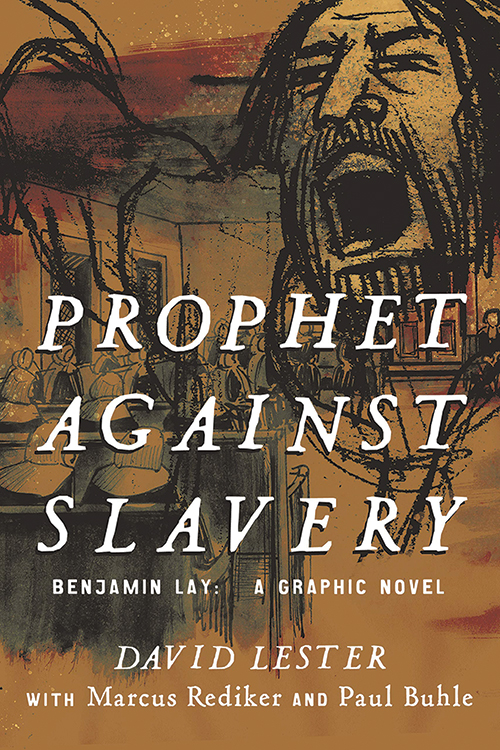
Prophet Against Slavery, Benjamin Lay: A Graphic Novel
Reviewed by Gwen Gosney Erickson
March 1, 2022
By David Lester with Marcus Rediker and Paul Buhle. Beacon Press, 2021. 100 pages. $15/paperback; $11.99/eBook.
Abolitionist Quaker Benjamin Lay gained well-deserved attention in recent years as an unconventional hero amongst both Quakers and non-Quakers. Controversial in his own time, a vital radical precursor to better-known Friends Anthony Benezet and John Woolman, and left out of both popular and academic histories and analyses of the Quakers and slavery for decades, awareness of Lay was reborn through Marcus Rediker’s well-received biography published in 2017. (See Larry Ingle’s review in September 2017 Friends Journal.) While many read the full-length biography, more learned of Lay through publicity surrounding the book, including Rediker’s feature article in the September 2017 issue of Smithsonian Magazine. This latest publication further expands opportunities to learn and absorb the story of radical abolitionist Benjamin Lay in a new format.
Paul Buhle writes at the end of the book that artist David Lester observed that “purely visual pages slow down the action and focus the reader’s thoughts.” The stirring story of Benjamin Lay’s unconventional life, filled with visceral actions against slavery and other injustices, lends itself very well to a visual format. Lay’s life was a testimony to speaking truth to power from the bottom up with actions best described as guerilla theater. Relating his story through graphic interpretation seems an especially appropriate choice to bring readers more fully into a sensory experience. This is no simple comic strip; it is an artistic work that presents traumatic real events. It portrays a social justice warrior engaged in the Lamb’s War, a classic tale of a hero struggling to fulfill his mission. The text from Rediker’s academic biography is translated by artist David Lester to re-engage readers on another level.
For those new to Lay, the basic story is all there in the graphic interpretation. Additionally, there is a one-page postscript briefly presenting context for Lay’s legacy. Marcus Rediker’s four-page afterword, “Why We Need Benjamin Lay,” reasserts key points, and presents reflections to further ground the reader in the story’s significance. The book concludes with Buhle’s essay “Comic Art and the Artist,” giving insights into the artist’s choices and the graphic storytelling form.
In Rediker’s 2017 biography, much of the last chapter explores the 1758 William Williams-Benjamin West portrait of Lay and later engravings based upon it. This includes Lay’s noteworthy physical form as a dwarf and hunchback, attributes that were used against him to imply he was unfit both mentally and physically. The black and white roughness of the illustrations is compelling and appropriate to convey the depth and struggle lived by a radical, simple-living vegetarian abolitionist.
Rather than limiting the reader to a single illustration or angle, the artistry of this latest interpretation relays the entire story to show the many emotions and travails of an eighteenth-century Quaker prophet.
Gwen Gosney Erickson is a member of Friendship Meeting in Greensboro, N.C., and Quaker archivist at Guilford College where she currently serves as co-chair of the Curry-Coffin Commission on Slavery, Race, and Recognition.


